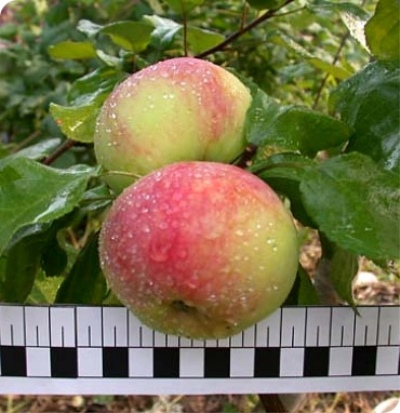
- Authors: S. I. Isaev (Russia, VNIIS named after I. V. Michurin)
- Taste: sweet and sour, dessert
- Scent: pleasant
- Fruit weight, g: 120
- Yield: up to 100 kg per tree
- The beginning of fruiting varieties: for 2-3 years
- Ripening terms: late summer
- Removable maturity: In the end of August
- Keeping quality: up to 30 days
- Appointment: universal
Apple trees of constant fruiting, such as Dessertnoe Isaeva, are in great demand. This early-growing variety is intended for cultivation in central Russia. He shows himself well in the southern regions.
Breeding history of the variety
The dessert apple tree was bred at VNIIS im. IV Michurin more than 50 years ago. The author of the culture was Sergey Ivanovich Isaev, a famous breeder, after whom the new variety was named. Cinnamon striped and Welsey were taken as a parental pair.
Description of the variety
The dessert variety is a medium-sized apple tree that usually reaches 4 meters in height. The crown of the tree is formed by long thin branches. In this regard, a bountiful harvest has to be maintained with the help of supports that will hold the heavy fruits. The color of the leaves is emerald. They are smooth, matte, with a thin long tip. There are jagged edges along the edges. In mid-May, when the apple tree begins to bloom, medium-sized white-pink flowers appear.
Features, pros and cons
The variety, which was obtained as a result of selection, has many positive qualities.
Let's list the main advantages:
- early-growing apple tree;
- immune to scab;
- the tree has an average height, which makes it convenient to harvest and care for the crop;
- good frost resistance;
- high and regular yield;
- taste at a height, juicy fruits.
The apple tree Dessertnoe Isaeva is quite easy to grow even in regions where gardening opportunities are limited.
But despite the fact that the variety has numerous advantages, it is not devoid of certain disadvantages, and they must also be taken into account when growing.
The main disadvantage lies in the need for a specific formation of the crown. This must be done, since not only the quantity, but also the quality of the crop will depend on the peculiarities of the structure of the tree. Otherwise, if you abandon this, the fruits can be crushed, and their number will decrease. The disadvantages include a not too long storage period for a ripe crop - apples are stored for no more than a month.
Ripening and fruiting
The variety Dessertnoe Isaeva is one of the early ripening varieties. The first fruiting can be seen already 2-3 years after planting in the ground. After which the apple tree will bear fruit without interruption, every year. In terms of ripening, the culture can be attributed to late summer. At the beginning of flowering in May, fruits ripen at the very end of August. You can determine the ripeness of apples by the abundant raspberry blush on the fruit.
Growing regions
It is possible to grow the culture in question with success in the middle lane and the southern regions of the country. The variety feels good in the Moscow region.
Yield
The Dessertnoe Isaeva variety has a high yield. So, from one tree you can get up to 100 kilograms of beautiful ruddy apples.
Fruits and their taste
The Dessertnoe Isaeva variety brings a crop of tasty and juicy medium-sized fruits. The weight of one fruit can be on average from 120 to 130 grams. The apples are round, slightly conical in shape. The ripe fruit has a yellow base color with a characteristic crimson blush, which is located over the entire surface of the apple.The skin is thin, the flesh is white, very tender and juicy, with a pleasant aroma. Fruits are sweet, slightly sour, rich in flavonoids and vitamin C. The greatest benefit can be obtained by eating fresh apples. The fruits are ideal for making jam, juice and other preparations.

Growing features
The apple tree Dessertnoe Isaeva should be planted on a site where there is protection from the cold wind, and the sun's rays will hit the tree even in winter. A few weeks before planting the seedling, they dig a hole 90 cm deep and 80 cm wide. The soil should be left in its place, loosened, fertilized with mineral and organic compounds.
Before direct planting, the seedling must be soaked for 4 hours in water. Support is required. After planting, you need to tamp the soil, tie the tree to a peg and water it while the water flows into the ground. For the first few years, you just need to water and weed the apple tree.
Starting from 2 years old, they begin to form the crown. For this, all branches, vertical branches are necessarily removed, part of the growth is shortened. Damaged, diseased and dry branches are removed, all wounds are treated with garden varnish.



Pollination
Dessertnoe Isaeva is a self-pollinated variety. Therefore, it is not necessary to plant it next to other apple trees.



The apple tree is a popular fruit crop among gardeners. It can be found in many summer cottages. But at the same time, such trees are often affected by various diseases. It is very important to recognize the disease in time and carry out the necessary procedures for a speedy recovery.Otherwise, the fruits will be spoiled, and the tree itself may die altogether.












































































